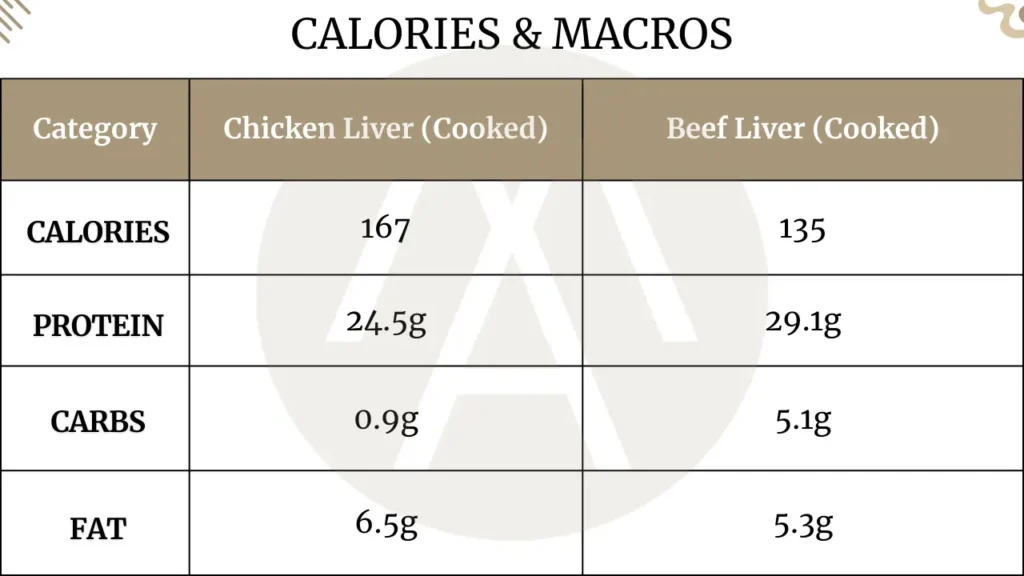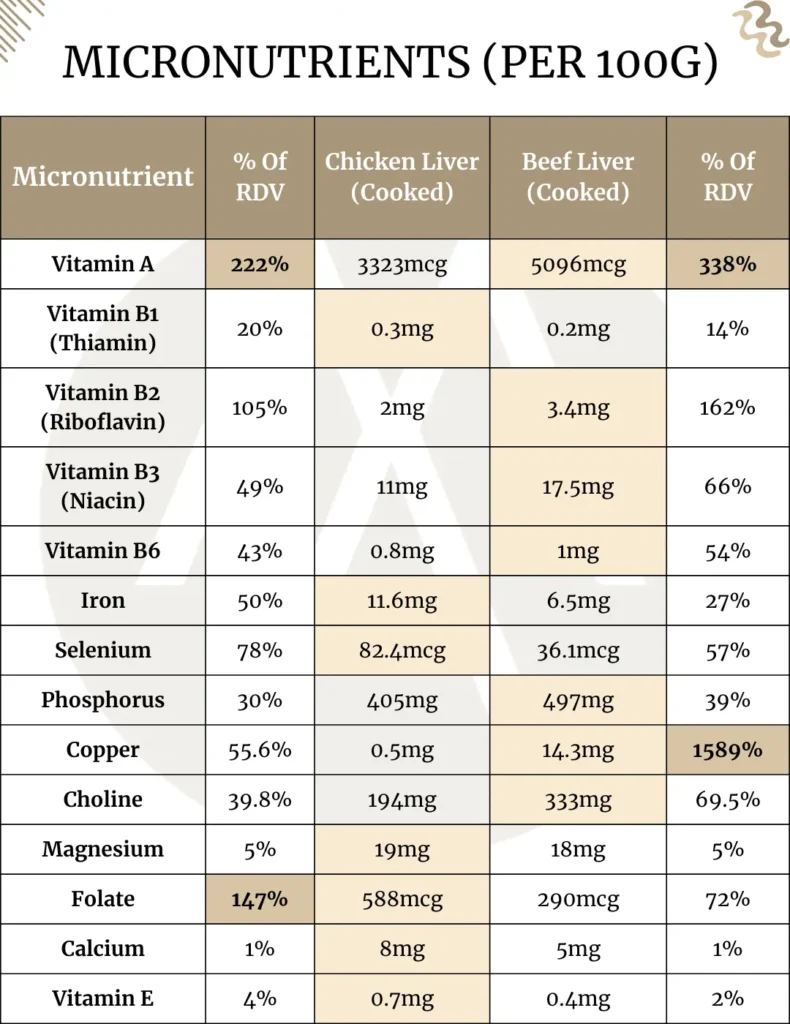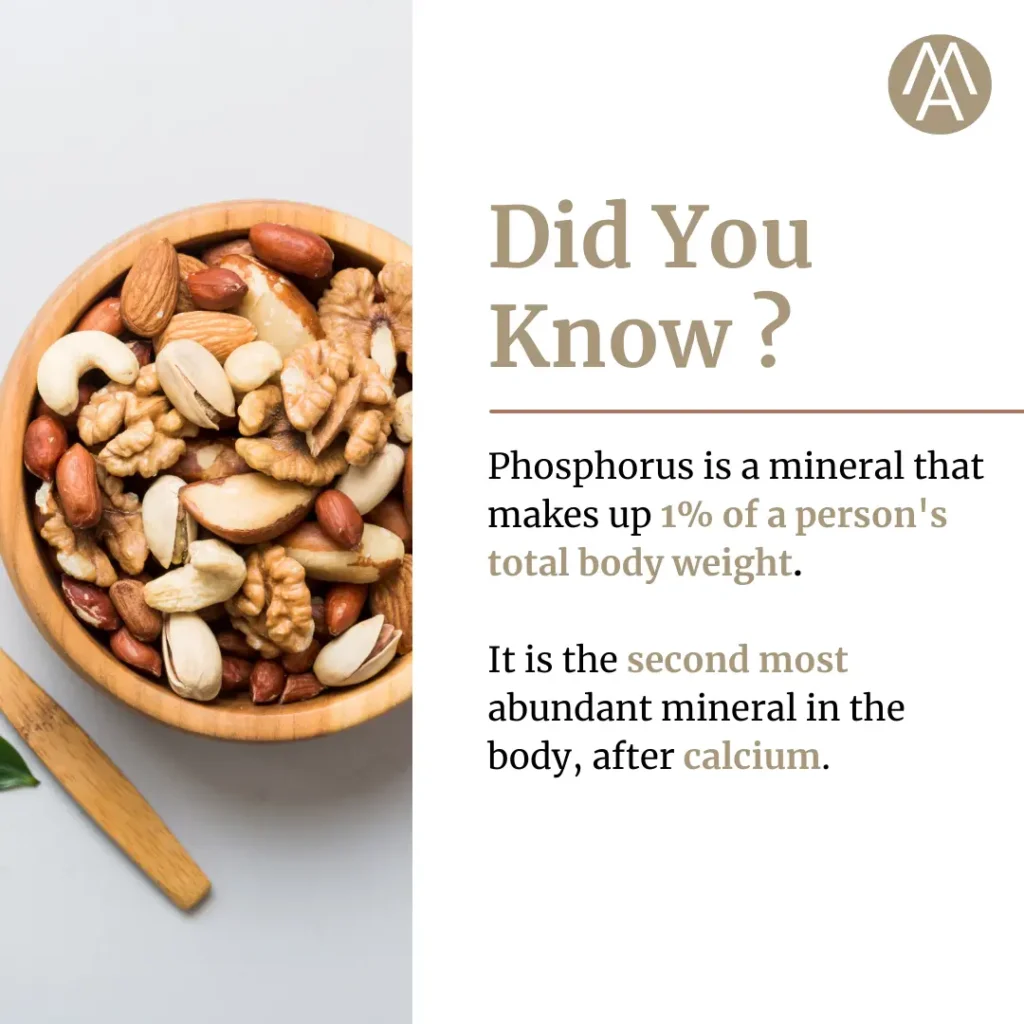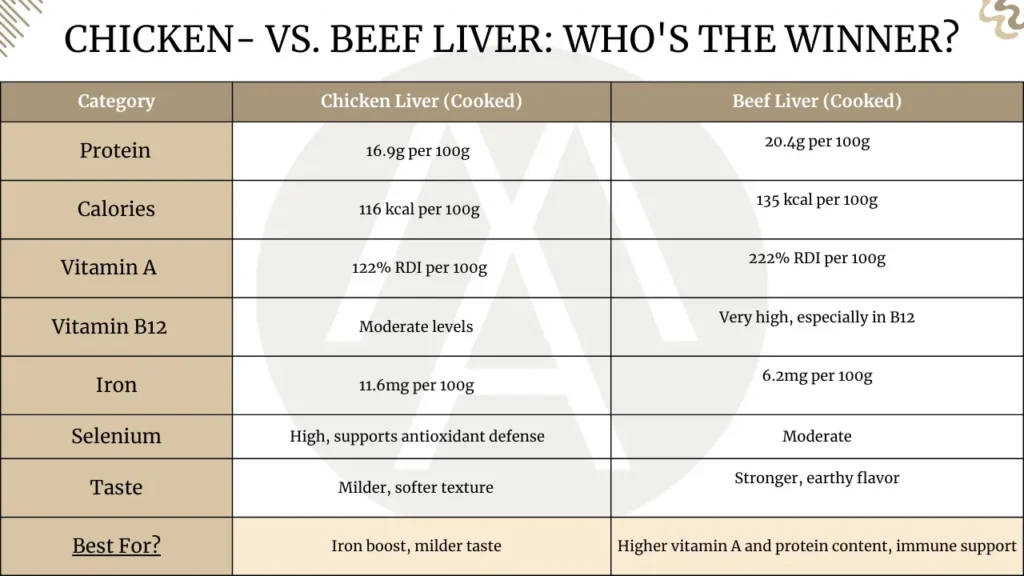Physical Address
304 North Cardinal St.
Dorchester Center, MA 02124
Physical Address
304 North Cardinal St.
Dorchester Center, MA 02124

Which liver reigns supreme? Is it the nutrient-packed powerhouse of beef liver or the iron-rich, milder chicken liver? Discover the ultimate showdown and find out which one you should add to your diet!
(Drum roll) – In the left corner, we have chicken liver. With its 16.9g of protein, 116 calories, and a shocking amount of vitamin A, it forms a real battle for the world champion in our right corner. Beef liver, also known as the Nutritional Powerhouse. With 20.4g of protein, 135 calories, and the ability to give you a vitamin B shock!
Who wins today’s battle of beef liver vs. chicken liver? Let me break it down for you.
Beef liver is commonly described as a superfood. It’s packed with vitamins and nutrients, especially vitamins A, B12, iron, zinc, folate, and protein are part of the benefit list.
Beef liver can be bought in the natural form or in supplements. Supplements containing the benefits of beef liver are often a combination of the above-mentioned nutrients. The beef liver is desiccated (freeze-dried), removing most of the water and fat.
Beef liver is part of the trend we see nowadays of people eating organs. Whether I’m a huge fan of this trend is irrelevant for now. Always make sure to choose grass-fed and pasture-raised cattle for your highest-quality liver.
With slightly worse macros and protein-calorie ratio, we have chicken liver. Chicken liver particularly stands out when it comes to minerals. Iron, selenium, and phosphorus are famous minerals chicken liver is rich in. One serving of chicken liver will probably get you to your RDI (Recommended Daily Intake)
Compared to beef liver, chicken liver is lighter in taste and texture. Pasture-raised chicken tends to be higher in healthy omega-3 fatty acids and vitamin A, boosting your immune system.
More on the benefits later on in this blog.
You got a minute? I’m going to list all of the benefits of eating liver here. Safe to say there are quite a few.
The liver is a powerhouse of a wide range of vitamins and minerals. Besides containing the perfect macros and lean protein, it is high in vitamins A, B6/B12, niacin, healthy fats, and iron.
One serving of liver will get you close to, if not over, your daily recommendation.
Not unfamiliar to you probably, but 100g of beef liver contains 11077 IU/3323.1 mcg of vitamin A, which is 222% of the RDI. Too much vitamin A, on the other hand, may lead to vitamin A toxicity, causing nausea, headaches, trouble breathing, and more.
Be aware of your vitamin A intake. Remember: everything with “too” before it is bad!
Besides building muscle, protein is also a filling macronutrient. It is crucial for boosting brain function, stabilizing blood sugar levels, and muscle building.
With 19-23g of high-quality protein per serving, beef liver stands out.
Anemia is the condition in which your blood doesn’t have sufficient red blood cells. Liver is high in red blood cells (iron), reducing your chances of anemia (together with vitamins C and B).
All of the vitamin B’s can be found in liver, especially vitamin B12. B vitamins help enzymes in your body do their job properly, such as breaking down carbohydrates and transporting nutrients through the body.
Vitamin B12 is known for keeping blood and nerve cells healthy and helping in the making of DNA.
There are way more, but let’s go on for now.
Let’s compare the nutritional values of both!
What are macros? What are micronutrients? Before we dive in, it’s important to know the difference.
Macros come down to protein, carbs, and fats. These are the ones most people focus on when deciding whether a product is “good” or “bad”.
Micronutrients are vitamins and minerals, such as vitamins A, B, B12, folate, and iron. There are way more micronutrients than there are macronutrients.

Interestingly. Beef liver contains fewer calories per 100g but way more carbs and slightly more protein. How? As we know, fat contains eight calories per gram, and protein and carbs four calories per gram.
While this is not the only difference, beef liver looks better from a macronutrient standpoint. But don’t judge yet! There is still much more to say from a micronutrient viewpoint.

Some small notices:
Now, let’s dive deeper into each micronutrient.
If you’ve read my blogs on beef liver or the carnivore diet, you already know that liver is extremely high in vitamin A. With 5096mcg of vitamin A per 100g, beef liver founds itself top of the bill. Vitamin A is important for normal vision, the immune system, reproduction, and growth and development
Be aware of your vitamin A intake, by the way, as vitamin A toxicity is not something to mess with. Chicken liver, on the other hand, is a bit lower in vitamin A but still exceeds the daily recommended amount by 122%.
Looking at the B vitamins (B1, B2, B3, and B12), I noticed that beef liver wins the battle again. Vitamin B is essential for transporting nutrients throughout the body and breaking down carbohydrates.
With vitamin B, you don’t need to worry much about toxicity as much as with vitamin A.
Folate, aka vitamin B9, is essential for red blood cell formation and healthy cell growth and function. It is also important in the early stages of pregnancy, to reduce the chances of defects to the brain or spine.
While found in beans, peas, and nuts, folate can be found in both beef and chicken liver. Chicken liver, however, contains 588 mcg of folate per 100 grams. Folate is important for everyone, but supplementing it may be worth it if you’re a pregnant woman.
Let’s have a look at some of the most important minerals found in chicken and beef liver.
Although beef is often referred to as “high in iron,” the chicken liver takes the cake when it comes to iron content. 100g of chicken liver contains 11.6mg of iron.
Iron is important for the production of hemoglobin, a protein in red blood cells that carries oxygen from the lungs to all parts of the body. Besides that, iron is also responsible for the production of myoglobin, a protein that provides oxygen to the muscles.
Less popular, but surely worth listing. Selenium is essential for helping fight free radicals, which can damage cell membranes and DNA. Both contenders are high in selenium.

Phosphorus, along with calcium, is essential for strong bones and teeth. It also helps regulate carbohydrates and fats and is important for the body’s protein production for growth.
Phosphorus is a master of all, because it also helps in:
Both beef and chicken liver are relatively high in phosphorus, but beef liver contains a little more of this crucial mineral.
Gold, silver, copper. Technically, both the copper found in nutrition and the copper found in mines are the same element. Nutritional copper is in tiny, safe amounts in foods, making it easy for our bodies to use. The other one… You get the points.
Copper helps produce energy, connect tissues, and form blood vessels. It’s also crucial for the nervous and immune systems and is essential for brain development and health.
BE CAREFUL with your copper intake, as beef liver is extremely high in copper. In the right amounts, copper supports these vital functions, but because it accumulates in the body, too much can be harmful, causing liver damage, abdominal cramps, nausea, diarrhea, and vomiting.
The last one I want to break down for you is choline. Choline is an essential nutrient most people lack. The most choline-rich foods are beef and chicken liver, salmon, and eggs.
Although I listed it as a mineral, it’s actually a water-soluble compound. Choline’s main function is optimal liver function, healthy brain development, muscle movement, nervous function, and metabolism.
Although chicken liver has a solid amount of choline in it, beef liver wins the choline battle.
If we would only care about health, we surely wouldn’t be enjoying life as much as we do. Taste is also important! Obviously, I’m not here to tell you whether beef or chicken liver tastes better.
But I can give you a detailed taste comparison based on experience!
Chicken liver is, when it comes to taste, a solid first step towards eating liver. It has a milder flavor and is a bit more soft when it comes to the texture. Some people complain that beef liver is a little too intense when it comes to flavor.
For those people, I recommend trying chicken liver instead. It can be made in a variety of ways and is ideal for people who prefer a milder taste.
Chicken liver is often made into paté, stir-fries, just grilled, or on a skewer with some onions, bell pepper, and spring onion.
I recommend trying beef liver for people who prefer a stronger, more powerful flavor. While it’s also slightly more expensive (obviously, beef is more expensive than chicken), it’s still affordable for most people.
Most specialized butchers and specialty meat markets have beef liver. However, most grocery shops nowadays have them too. It’s important to choose the right one tho, as there is a lot of variability when it comes to the quality.
Beef liver is slightly more bitter, soaking it in milk can partly reduce the bitterness. Also, it tastes a bit more “earthy”.
Here are some recipes that are worth a try! I find these delicious, while still maintaining excellent macro-ratios.

This French-inspired pâté is smooth, creamy, and full of flavor, perfect as an appetizer.

The smoky flavor of bacon pairs beautifully with chicken liver for a savory appetizer.
A twist on classic chicken marsala, this dish uses chicken livers for a rich, flavorful entrée.

I already wrote a blog on beef liver recipes! Click the following button to check them out.
While liver packs a punch in nutrients, overdoing it can have some downsides. Liver, particularly beef liver, is incredibly rich in vitamin A and copper, two nutrients you don’t want to consume in excessive amounts. Vitamin A is essential for vision, immunity, and skin health, but too much can lead to toxicity. Symptoms of vitamin A toxicity include nausea, dizziness, headaches, and in extreme cases, even liver damage.
While crucial for energy production, connective tissue formation, and iron metabolism, copper can accumulate in the body if consumed in excess, causing symptoms like abdominal pain, diarrhea, and even serious liver issues.
The FDA recommends limiting liver consumption to around two weekly servings to avoid these risks. Also, if you’re familiar with certain health conditions, like gout or kidney problems, you may want to stay away from liver due to its high purine content, which could exacerbate their symptoms.

Both chicken and beef liver bring incredible nutrients to the table, but each excels in unique ways.
I prefer beef liver for the nutritional benefits, the vitamin A content, and the macro-efficiency. However, if I were to start at this current moment, I would start with chicken liver, thanks to its lighter taste and the fact that it’s a little milder on the stomach.
The Verdict? For intense nutrients and protein, beef liver is a top choice. If you’re seeking high iron with a lighter taste, chicken liver is a winner. Either way, both options deliver major health benefits, so pick the one that aligns with your personal goals and taste preferences!
Both chicken and beef liver are nutritional powerhouses, but the healthiest choice depends on your specific needs.
If you need a gentler flavor and iron boost, chicken liver is ideal, while beef liver is best for a vitamin-rich, high-protein option.
Organ meats are all nutrient-dense, but liver generally tops the list due to its high levels of vitamins A, B12, iron, and folate, which support immunity, energy production, and red blood cell formation.
Yes, eating beef liver can be highly beneficial due to its nutrient-rich profile. Beef liver is packed with essential vitamins and minerals, including vitamin A, vitamin B12, iron, zinc, and folate.
These nutrients support immune health, energy production, and cellular function. However, because liver is so high in vitamin A and copper, moderation is key to avoid potential toxicity.
Eating liver once or twice a week can be a great way to boost nutrient intake without overdoing it.